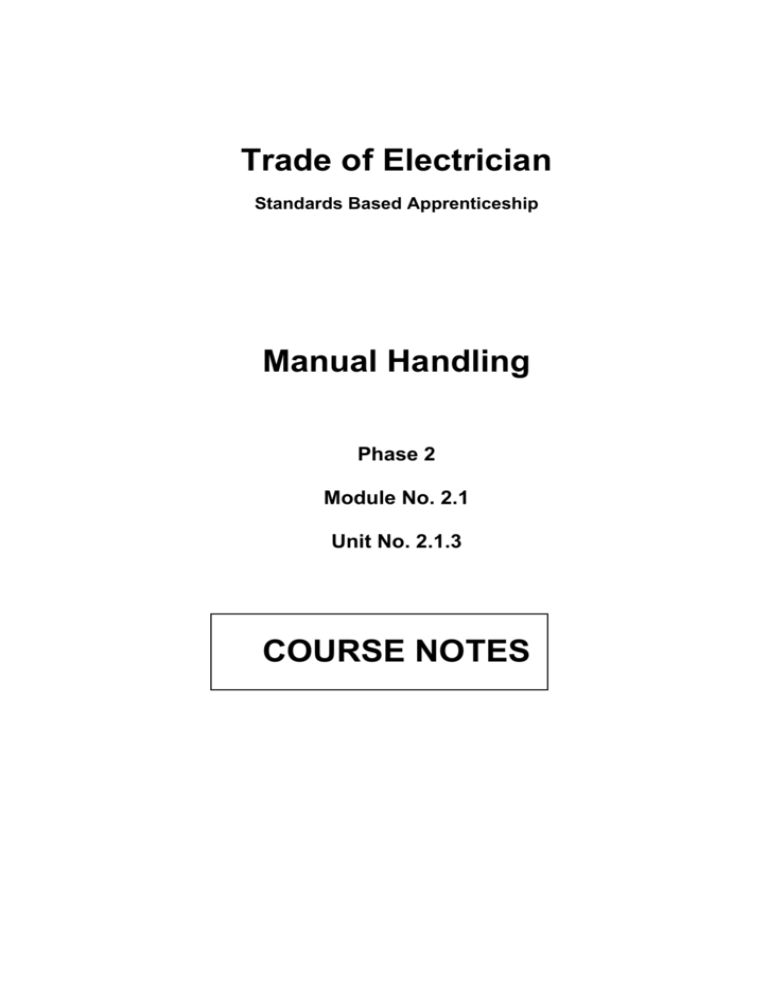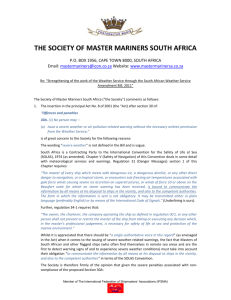
Trade of Electrician
Standards Based Apprenticeship
Manual Handling
Phase 2
Module No. 2.1
Unit No. 2.1.3
COURSE NOTES
SOLAS
Electrical Course Notes - Unit 2.1.3
Created by Michael Jackson – Dublin HO
Chris Ludlow - Dundalk TC
Revision 1 May 2006 by
Chris Ludlow - Dundalk TC
Revision 2. Feb 2008 by
Chris Ludlow - Dundalk TC
Revision 3, November 2013
SOLAS
Published by
27-33 Upper Baggot Street
Dublin 4
Ireland
© SOLAS - 2013
All rights reserved. No part of this publication may be reproduced, stored in a retrieval system or
transmitted in any form or by any means, electronic, mechanical, photocopying, recording or
otherwise, without the prior permission of the copyright owner.
Revision 3, November 2013
2
SOLAS
Electrical Course Notes - Unit 2.1.3
Table of Contents
TABLE OF CONTENTS ........................................................................................................ 3
INTRODUCTION ................................................................................................................... 9
INTRODUCTION ................................................................................................................... 9
FOREWORD ......................................................................................................................... 10
EMPLOYER’S DUTY .......................................................................................................... 10
EMPLOYEE’S DUTY .......................................................................................................... 10
STRUCTURE OF THE SPINE............................................................................................ 11
PREGNANT EMPLOYEE ................................................................................................... 12
HANDLING LOADS ............................................................................................................ 12
MOVING THINGS THE RIGHT WAY............................................................................. 15
MOVING THINGS THE WRONG WAY .......................................................................... 16
PREVENT PAIN, INJURIES AND DAMAGE.................................................................. 17
Revision 3, November 2013
3
SOLAS
Electrical Course Notes - Unit 2.1.3
LIFTING......... 18
LIFTING ................................................................................................................................. 19
Revision 3, November 2013
4
SOLAS
Electrical Course Notes - Unit 2.1.3
CARRYI
NG ........................................................................................................................................... 19
CARRYING ........................................................................................................................... 20
Revision 3, November 2013
5
SOLAS
Electrical Course Notes - Unit 2.1.3
UPLOADIN
G .............................................................................................................................................. 20
UPLOADING ......................................................................................................................... 21
SPECIAL LIFTS .................................................................................................................... 22
Revision 3, November 2013
6
SOLAS
Electrical Course Notes - Unit 2.1.3
AWKW
ARD OBJECTS AND OVERHEAD LIFTS ....................................................................... 22
AWKWARD OBJECTS AND OVERHEAD LIFTS ......................................................... 23
PUSHING AND PULLING SAFETY ................................................................................. 24
SPECIAL OBJECTS REQUIRE SPECIAL HANDLING ............................................... 25
TEAM EFFORT .................................................................................................................... 26
Revision 3, November 2013
7
SOLAS
Electrical Course Notes - Unit 2.1.3
LEGAL OBLIGATIONS ...................................................................................................... 28
EIGHT PRINCIPLES OF LIFTING ................................................................................... 29
Revision 3, November 2013
8
SOLAS
Electrical Course Notes - Unit 2.1.3
Introduction
Welcome to this section of your course, which is designed to educate you, the learner, on the
proper procedures for lifting carrying and moving loads in a safe and efficient manner.
Objectives
By the end of this unit you will:
List the main statutory requirements of both employers and employees in relation to
manual handling and general safety in the workplace.
Explain the structure of the spine.
Explain the functions of muscles, tendons and ligaments.
Explain the types of injury that may occur from lifting and handling loads.
Explain the requirement for a pre-lift analysis of a load.
Explain how the body should be positioned before attempting a lift.
Explain and demonstrate good handling techniques for lifting workplace objects.
Explain and demonstrate good handling techniques for pushing and pulling a workplace
object.
Demonstrate the correct procedures for team lifting a load.
Describe the various types of handling devices and in what situations they may be used.
Correctly demonstrate how to handle a typical workplace load using a handling aid.
Reasons
The information in this unit is essential, if you are to avoid back injuries when lifting, carrying
or moving loads.
Revision 3, November 2013
9
SOLAS
Electrical Course Notes - Unit 2.1.3
Foreword
Approximately 35% of accidents reported to the HSA in the year 2000 resulted from Manual
Handling incidents. Four out of five adults will experience back pain at some stage in their
lives. About 50% of people off work with back pain have a recurrence of the problem within
one year. Roughly 5% of back pain leads to prolonged disability. The problem is equally
common among males and females.
It usually results from: Heavy manual work ( forceful exertion, bending, twisting )
Working in a stooped posture
Prolonged sitting in a fixed position
Vibration
Stress
Employer’s Duty
The duty of the employer towards employees is to:
Assess manual handling risks.
Take measures where possible to avoid manual handling.
Provide manual handling training.
Carry out risk assessment where manual handling is unavoidable.
Provide employee with precise information about the load.
Provide a reasonably safe place of work.
Provide reasonably safe plant and equipment
Provide reasonably safe systems of work.
Employee’s Duty
The duty of the employee is to:
Take reasonable care for his safety and welfare and that of others in the workplace.
Use any equipment, protective clothing or other means provided by the employer for
securing his safety and welfare in the workplace.
Report to his employer any problems or defects which might endanger health and safety.
Not intentional or reckless interference with or misuse any equipment.
Revision 3, November 2013
10
SOLAS
Electrical Course Notes - Unit 2.1.3
Structure of the Spine
It is well known that the vertebral column, or spine, has the shape of
an elongated S. At chest level it has a slight backward curve, and in
the lumbar region it has a slight forward curve. This construction
gives the spine elasticity, to absorb the shocks of running and
jumping.
The loading on the vertebral column increases from above
downwards, and is at its greatest in the lower five lumbar vertebrae.
An intervertebral disc separates each pair of vertebrae.
Degeneration of a disc first affects the margin of the disc, which is
normally tough and fibrous.
A tissue change is brought about by loss of water, with the result
that the fibrous ring becomes brittle and fragile and loses its
strength. At first the degenerative change merely makes the disc
flatter, with the risk of damage to the mechanics of the spine, or
even of displacement of the vertebrae. Under these conditions quite
small actions such as lifting a weight, a slight stumble or similar
incidents may precipitate severe backache and lumbago.
When degeneration of the disc has progressed further, any sudden
force upon it may squeeze the viscous internal fluid out through the
ruptured outer ring and so exert pressure either on the spinal cord
itself or on the nerves running out from it. This is what happens in
the case of a “Slipped Disc” or disc herniation.
Pressure on nerves, narrowing of the spaces between vertebrae,
pulling and squeezing at adjoining tissues and ligaments of the
joints are the causes of the variety of aches, muscular cramps and
paralyses including lumbago and sciatica which commonly
accompany disc degeneration.
Back troubles are painful and reduce one’s mobility and vitality.
They lead to long absences from work, and in modern times are
among the main causes of early disability. They are comparatively
common in the age group 20 – 40 with certain occupations
( labourer, farmer, porter, nursing staff, etc.) being particularly
vulnerable to disc troubles. Moreover, workers with physically
active jobs suffer more from ailments of this nature, and their work
is more affected as a result.
Revision 3, November 2013
11
SOLAS
Electrical Course Notes - Unit 2.1.3
Pregnant Employee
Risks due to manual work must be assessed for pregnant employees and employees who
have recently given birth.
Health and safety leave must be given if the maternity employee cannot be protected
from the risks identified.
Certification of risk by employer for social welfare purposes.
Handling Loads
Avoid
Very heavy loads.
Arching of the spine.
Excessive or repeated twisting.
Over-stretching or over-reaching.
Ensure
A good secure grip
Awareness of the weight and stability of the load.
Correct stance and lift posture.
Smooth quick lift.
Correct protective clothing and equipment.
Proper co-ordination of team lifts.
Revision 3, November 2013
12
SOLAS
Electrical Course Notes - Unit 2.1.3
Stooping to Lift
Revision 3, November 2013
13
SOLAS
Electrical Course Notes - Unit 2.1.3
Bending the Knees
Revision 3, November 2013
14
SOLAS
Electrical Course Notes - Unit 2.1.3
Moving Things the Right Way
Revision 3, November 2013
15
SOLAS
Electrical Course Notes - Unit 2.1.3
Moving Things the Wrong Way
Revision 3, November 2013
16
SOLAS
Electrical Course Notes - Unit 2.1.3
Prevent Pain, Injuries and Damage
Revision 3, November 2013
17
SOLAS
Electrical Course Notes - Unit 2.1.3
Revision 3, November 2013
18
SOLAS
Electrical Course Notes - Unit 2.1.3
Lifting
To avoid injury do warm-up exercises before lifting.
Revision 3, November 2013
19
SOLAS
Electrical Course Notes - Unit 2.1.3
Carrying
Revision 3, November 2013
20
SOLAS
Electrical Course Notes - Unit 2.1.3
Uploading
Revision 3, November 2013
21
SOLAS
Electrical Course Notes - Unit 2.1.3
Special Lifts
Revision 3, November 2013
22
SOLAS
Electrical Course Notes - Unit 2.1.3
Awkward Objects and Overhead Lifts
Revision 3, November 2013
23
SOLAS
Electrical Course Notes - Unit 2.1.3
Pushing and Pulling Safety
Revision 3, November 2013
24
SOLAS
Electrical Course Notes - Unit 2.1.3
Special Objects Require Special Handling
Revision 3, November 2013
25
SOLAS
Electrical Course Notes - Unit 2.1.3
Team Effort
Revision 3, November 2013
26
SOLAS
Electrical Course Notes - Unit 2.1.3
Revision 3, November 2013
27
SOLAS
Electrical Course Notes - Unit 2.1.3
Legal Obligations
Revision 3, November 2013
28
SOLAS
Electrical Course Notes - Unit 2.1.3
Eight Principles of Lifting
1. Assess the task, the area and the load
2. Broad stable base - feet flat on floor
3. Bend the knees
4. Back straight
5. Firm grip
6. Arms in line with trunk
7. Weight close to centre of gravity
8. Turn feet in direction of movement
Revision 3, November 2013
29








